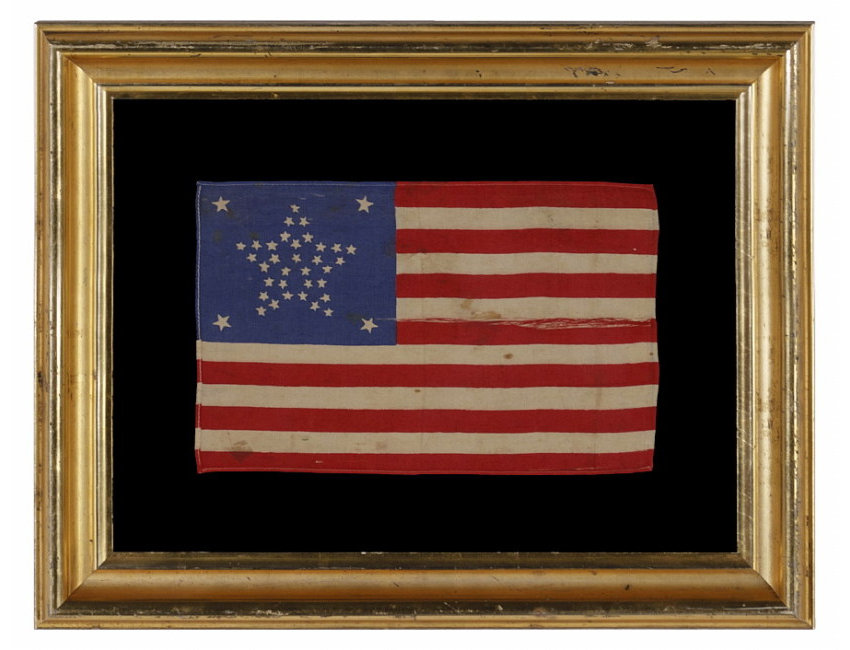|
37 STARS IN THE �GREAT STAR� PATTERN WITH A STAR IN EACH CORNER, A RARE, BEAUTIFUL, AND DESIRABLE DESIGN, MADE DURING THE PERIOD OF RECONSTRUCTION OF THE SOUTH, POSSIBLY IN CELEBRATION OF THE CENTENNIAL OF AMERICAN INDEPENDENCE, NEBRASKA STATEHOOD, 18
|
|

|
Description: |
|
| Fantastic and rare 37 star American parade flag, printed on silk. The stars are arranged in what is known as the "Great Star" configuration, a star made out of stars. Sometimes also called the "Great Flower" or the "Great Luminary" pattern, the Great Star is the Rolls Royce of all 19th century geometric designs among flag collectors. It probably came about shortly before 1818, when Congressman Peter Wendover of New York requested that Captain Samuel Reid, a War of 1812 Naval hero, helped to create a new design that would become the third official format of the Stars & Stripes. The primary concern of ship captains was that the signal remained easily recognized on the open seas. The concept of placing all the stars in a star-shaped pattern would have kept the constellation in roughly the same format as the number of states grew and more stars were added, in a distinct design that could be quickly identified through a spyglass. Though the proposal was rejected by President Monroe, due to the increased cost of arranging the stars in this manner, the Great Star was produced by anyone willing to make it. Its rarity today, along with its beauty, has driven its desirability among collectors.
The 37th state, Nebraska, joined the Union on March 1st, 1867. The 37 star flag was official from that year until 1877, although it generally fell out of use in 1876 with the addition of Colorado. The 37 star-count is scarce in comparison to the flags that immediately preceded and followed it. This is due primarily to the lack of major patriotic events during the period they were generally used, which followed the Civil War yet preceded the 100-year anniversary of our nation's independence. While the 37 star flag was still official in 1876, it was well known that at least one more state would be joining the Union that year. This caused flag makers to cease production in favor of 38 and 39 star flags, which were made as early as 1875 or even prior. For this reason, 37 star flags were seldom produced for our nation's centennial, where 38 and 13 (to commemorate the original 13 colonies) star counts were preferred.
Even so, some 37 star flags survive, with hand-inscribed or embroidered dates, that were evidently used in the fanfare of our nation's 100-year anniversary. I have long presumed that some of those with more whimsical star configurations, such as this flag, were produced specifically for that purpose.
Construction: Printed silk, hemmed with treadle stitching on top, bottom, and hoist ends.
Mounting: The gilded American frame dates to the period between 1840 and 1870. This is a sandwich mount between U.V. protective acrylic and 100% cotton twill, black in color. The background fabric has been washed to reduce excess dye. An acid-free agent was added to the wash to further set the dye and the fabric was heat-treated for the same purpose. A layer of ivory colored silk was placed between the flag and the background to strengthen its color against the dark ground, to mask areas affected by splitting, and to serve as an additional barrier between the flag and the black cotton. |
| Inventory Number: |
|
|
|
Dealer |
Jeff R. Bridgman American Antiques, llc |
| Contact |
Jeff Bridgman |
Phone: (717) 502-1281 |
|
| Period: |
19th Century (1801-1900) |
|
| Date: |
1867-76 |
|
| Origin: |
|
|
| Condition: |
There are a couple of very minor splits in the silk fabric, accompanied by a significant split that runs laterally from the fly end of the canton to the fly end of the stripes. Between the years of 1820 and 1850, the measure by which silks were sold changed from length to weight. Merchants searched for ways to make it heavier in order to get more money for the same amount of fabric. Mineral salts and other agents were employed in the task, and most or all of these additives were caustic to the fabric over time, causing it to split more easily. This is especially true of silk flags made during the second half of the 19th century. |
|
| Measurements: |
Frame: 15.5" x 19.75" Flag: 7.5" x 12" |
|
| Inventory |
Other Inventory by this Dealer |
|
| Web-site: |
http://www.jeffbridgman.com |
|
| Price: |
SOLD |
|
| E-mail: |
Inquire
|
|
Click thumbnail
to view larger
|
Views: 2305 |
|
|
|
